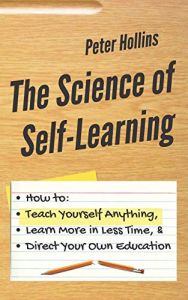The Science of Self-Learning: How to Teach Yourself Anything, Learn More in Less Time, and Direct Your Own Education (Learning how to Learn) Peter Hollins Peter Hollins, 2018
The Science of Self-Learning: How to Teach Yourself Anything, Learn More in Less Time, and Direct Your Own Education (Learning how to Learn) by Peter Hollins is a comprehensive guide to self-learning. In this book, Hollins provides readers with tools and strategies that make self-learning not only easier but also more rewarding.
Traditional learning methods are losing traction in a rapidly changing world. In the 21st century, productive opportunities for self-learning abound. To succeed as a self-learner, you need discipline, motivation, and a clear strategy and plan. Hollins's manual is well-organized, easy to use as a reference, and provides meaningful, illustrative examples.
The book is divided into several sections, each focusing on a different aspect of self-learning. In the first section, Hollins highlights the benefits of self-learning over traditional learning methods. He discusses how self-learning is infinite, sets you up for lifelong learning, allows you to study subjects from a different perspective, helps develop self-discipline, and opens new and unique opportunities.
In the second section, Hollins introduces Susan Kruger’s “Learning Success Pyramid,” which provides a foundation for approaching self-learning. To learn well, structure your learning journey. Confidence, self-management, and learning are the three blocks that make up Kruger's pyramid.
In the third section, Hollins discusses intrinsic motivation and how it is more rewarding than extrinsic motivation. He emphasizes the importance of autonomy, mastery, and purpose in generating intrinsic motivation.
The fourth section is about organizing information. Self-learning requires a different methodology to avoid feeling overwhelmed or demoralized. The “SQ3R” method provides a road map for your learning journey. SQ3R has five components: Survey, Question, Read, Recite, and Review.
The fifth section is about reading. Hollins discusses how most people are inefficient readers, reading about 300 words a minute. He provides four techniques to improve your reading speed and retention.
The sixth section is about how to read a book. Mortimer Adler wrote How to Read a Book to help readers improve their reading skills. He broke up reading into four “levels” that differentiate according to “purpose, effort, and time.”
In the seventh section, Hollins emphasizes that self-learning helps you build skills and habits that last a lifetime. He discusses Benjamin Franklin's approach to self-improvement and how adopting his approach can teach you to adopt worthy habits and practices on an alternating, unhurried schedule.
The eighth section is about critical thinking. Hollins discusses how critical thinking is essential to learning. He provides various methods for critical thinking, such as asking “why” questions, isolating key facts, and seeking comparisons.
In the ninth section, Hollins discusses how an essential component of self-learning is researching from scratch. He provides five steps for conducting research, such as gathering information and filtering your sources.
In the final section, Hollins discusses how the self-learning journey optimizes the growth mind-set. He emphasizes that success for self-learners depends on mind-set and how people tend to have either fixed or growth mind-sets. Self-learning demands a growth mind-set. Don’t let failure deter you; stay the course and have faith that you can learn almost anything.
Overall, The Science of Self-Learning is an excellent guide for anyone interested in self-learning. Hollins provides practical advice and strategies that anyone can use to teach themselves anything, learn more in less time, and direct their own education. If you are looking to become an autodidact, then this book is a must-read.
"The Science of Self-Learning" by Peter Hollins is a comprehensive guide to self-learning, providing readers with strategies and tools to teach themselves anything they want to learn. The book covers a wide range of topics, including self-motivation, critical thinking, reading techniques, research methods, and self-discipline. It also includes practical advice on how to structure your learning journey, set goals, and develop habits that will make self-learning a lifelong practice.
Overall, the book is well-organized, easy to understand, and offers meaningful examples to illustrate its points. It provides readers with a solid foundation for approaching self-learning and encourages them to adopt a growth mindset, emphasizing that anyone can learn almost anything with perseverance, dedication, and the right strategies. The book is suitable for readers of all ages and backgrounds who are interested in self-improvement and personal growth.
